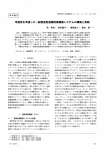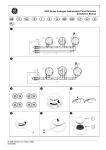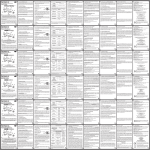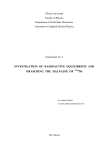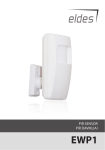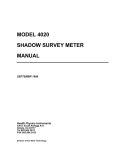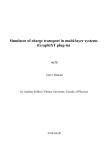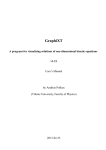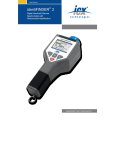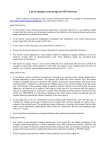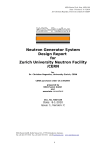Download Experiment No. 9. Absorption of alpha particles and electrons
Transcript
Vilnius University Faculty of Physics Department of Solid State Electronics Laboratory of Atomic and Nuclear Physics Experiment No. 9 ABSORPTION OF ALPHA PARTICLES AND ELECTRONS by Andrius Poškus (e-mail: [email protected]) 2015-09-13 Contents The aim of the experiment 2 1. Tasks 2 2. Control questions 2 3. The types of ionizing radiation 3 4. Interaction of charged particles with matter 4 4.1. Interaction of heavy charged particles with matter 4 4.2. Interaction of electrons with matter 5 4.3. Mass stopping power 6 4.4. Estimation of particle path in a material from initial and final energies. Particle range 7 5. Experimental setup for investigation of absorption of alpha particles 11 6. Measurement procedure for investigation of absorption of alpha particles 12 7. Ratemeter for investigation of alpha particle absorption. User’s manual 13 8. Experimental setup for investigation of absorption of beta particles 17 9. Measurement procedure for investigation of absorption of beta particles 21 10. Analysis of alpha particle absorption data 25 11. Analysis of beta particle absorption data 26 12. Linear fitting 27 2 The aim of the experiment Measure dependence of alpha and beta radiation intensity on distance traveled by the particles in various materials. Determine the range of the particles in those materials. Using an empirical range-energy relationship, determine the energy of alpha particles emitted by the 241Am source. Compare the obtained results with the known values given in literature or calculated from empirical formulas. Compare the observed regularities of alpha and beta particle absorption. 1. Tasks 1. Measure the dependence of the counting rate of alpha particles on the distance between the 241Am (americium-241) alpha source and the Geiger-Müller counter. 2. Measure the dependence of the counting rate of beta particles on thickness of aluminum and organic glass absorbers placed between the 90Sr/90Y (strontium-90 / yttrium-90) source and the Geiger-Müller counter. 3. Plot the dependence of the angular density of α particle flux on the distance. 4. Plot the absorption curves of beta particles. 5. Determine the mean range in air of α particles emitted by 241Am (taking into account the energy loss in the mica window of the counter). Using the empirical range-energy relation, calculate the energy of the α particles. 6. Determine the absorption coefficients and ranges of β particles in aluminum and organic glass. Compare the obtained values of the range with the value predicted by the empirical formula. 7. Discuss the observed peculiarities of absorption of α and β particles in matter. 2. Control questions 1. What are the types of ionizing radiation? 2. What it the origin of energy losses of charged particles in matter? 3. Explain the concept of the stopping power of the medium. What are the main parameters determining the rate of energy loss? 4. What are the differences between interaction of heavy charged particles (such as alpha particles) with matter and interaction of electrons with matter? 5. Explain the concept of particle range and its difference from the average penetration depth. 6. How is the range determined from the absorption curve? 7. Why is it necessary in this experiment to divide the measured absorption curve by the solid angle? 8. Explain the method of calculating air thickness which corresponds to the same energy loss of particles as in the mica window of the detector. Recommended reading: 1. Krane K. S. Introductory Nuclear Physics. New York: John Wiley & Sons, 1988. p. 193 − 198, 217 – 220. 2. Lilley J. Nuclear Physics: Principles and Applications. New York: John Wiley & Sons, 2001. p. 129 − 136. 3. Knoll G. F. Radiation Detection and Measurement. 3rd Edition. New York: John Wiley & Sons, 2000. p. 29 – 48, 118. 3 3. The types of ionizing radiation Ionizing radiation is a flux of subatomic particles (e. g. photons, electrons, positrons, protons, neutrons, nuclei, etc.) that cause ionization of atoms of the medium through which the particles pass. Ionization means the removal of electrons from atoms of the medium. In order to remove an electron from an atom, a certain amount of energy must be transferred to the atom. According to the law of conservation of energy, this amount of energy is equal to the decrease of kinetic energy of the particle that causes ionization. Therefore, ionization becomes possible only when the energy of incident particles (or of the secondary particles that may appear as a result of interactions of incident particles with matter) exceeds a certain threshold value – the ionization energy of the atom. The ionization energy is usually of the order of 10 eV (1 eV = 1,6022∙10−19 J). Ionizing radiation may be of various nature. The directly ionizing radiation is composed of highenergy charged particles, which ionize atoms of the material due to Coulomb interaction with their electrons. Such particles are, e. g., high-energy electrons and positrons (beta radiation), high-energy 4He nuclei (alpha radiation), various other nuclei. Indirectly ionizing radiation is composed of neutral particles which do not directly ionize atoms or do that very infrequently, but due to interactions of those particles with matter high-energy free charged particles are occasionally emitted. The latter particles directly ionize atoms of the medium. Examples of indirectly ionizing radiation are high-energy photons (ultraviolet, X-ray and gamma radiation) and neutrons of any energy. Particle energies of various types of ionizing radiation are given in the two tables below. Table 1. The scale of wavelengths of electromagnetic radiation Spectral region Radio waves Infrared rays Visible light Ultraviolet light X-ray radiation Gamma radiation Approximate wavelength range 100000 km – 1 mm 1 mm – 0,75 μm 0,75 μm – 0,4 μm Ionizing electromagnetic radiation: 0,4 μm – 10 nm 10 nm – 0,001 nm < 0,1 nm Approximate range of photon energies 1∙10−14 eV – 0,001 eV 0,001 eV – 1,7 eV 1,7 eV – 3,1 eV 3,1 eV – 100 eV 100 eV – 1 MeV > 10 keV Table 2. Particle energies corresponding to ionizing radiation composed of particles of matter Radiation type Alpha (α) particles (4He nuclei) Beta (β) particles (electrons and positrons) Thermal neutrons Intermediate neutrons Fast neutrons Nuclear fragments and recoil nuclei Approximate range of particle energies 4 MeV – 9 MeV 10 keV – 10 MeV < 0,4 eV 0,4 eV – 200 keV > 200 keV 1 MeV – 100 MeV The mechanism of interaction of particles with matter depends on the nature of the particles (especially on their mass and electric charge). According to the manner by which particles interact with matter, four distinct groups of particles can be defined: 1) heavy charged particles (such as alpha particles and nuclei), 2) light charged particles (such as electrons and positrons), 3) photons (neutral particles with zero rest mass), 4) neutrons (neutral heavy particles). This experiment concerns only the first two mentioned type of particles (alpha particles and electrons). 4 4. Interaction of charged particles with matter 4.1. Interaction of heavy charged particles with matter In nuclear physics, the term “heavy particles” is applied to particles with mass that is much larger than electron mass (me = 9,1·10−31 kg). Examples of heavy particles are the proton (charge +e, mass mp = 1,67·10−27 kg) and various nuclei (for example, 4He nucleus, which is composed of two protons and two neutrons). When radiation is composed of charged particles, the main quantity characterizing interaction of radiation with matter is the average decrease of particle kinetic energy per unit path length. This quantity is called the stopping power of the medium and is denoted S. An alternative notation is −dE/dx or |dE/dx| (such notation reflects the mathematical meaning of the stopping power: it is opposite to the derivative of particle energy E relative to the traveled path x). The main mechanism of the energy loss of heavy charged particles (and electrons with energies of the order of a few MeV or less) is ionization or excitation of the atoms of matter (excitation is the process when internal energy of the atom increases, but it does not lose any electrons). All such energy losses are collectively called ionization energy losses (this term is applied to energy losses due to excitation, too). Atoms that are excited or ionized due to interaction with a fast charged particle lie close to the trajectory of the incident particle (at a distance of a few nanometers from it). The nature of the interaction that causes ionization or excitation of atoms is the so-called Coulomb force which acts between the incident particles and electrons of the matter. When F|| -e an incident charged particle passes by an atom, it continuously interacts with the electrons of the atom. For example, if the incident particle has a positive electric charge, it continuously “pulls” the electrons (whose charge is negative) toward itself (see Fig. 1). If the pulling force is sufficiently strong and if its time F variation is sufficiently fast (i. e. if the incident particle‘s velocity b is sufficiently large), then some of the electrons may by liberated from the atom (i. e., the atom may be ionized). Alternatively, the atom may be excited to higher energy levels without ionization. v ze Coulomb interaction of the incident particles with atomic x=0 nuclei is also possible, but it has a much smaller effect on the motion of the incident charged particles, because the nuclei of the Fig. 1. The classical model of ionization of an atom due to Coulomb interaction of its material occupy only about 10−15 of the volume of their atoms. electrons with an incident heavy charged Using the laws of conservation of energy and particle. ze is the electric charge of the momentum, it can be proved that the largest energy that a non- incident particle, −e is the electron charge relativistic particle with mass M can transfer to an electron with mass me is equal to 4meE/M, where E is kinetic energy of the particle. Using the same laws, it can be shown that the largest possible angle between the direction of particle motion after the interaction and its direction prior to the interaction is equal to me / M. Since M exceeds me by three orders of magnitude (see above), we can conclude that the decrease of energy of a heavy charged particle due to a single excitation or ionization event is much smaller than the total kinetic energy of the particle and the incident particle practically does not change its direction of motion when it interacts with an atom (i. e., the trajectories of heavy charged particles in matter are almost straight). Note: The change of the direction of particle motion is called scattering. The quantum mechanical calculation of the mentioned interaction gives the following expression of the stopping power due to ionization energy losses: ⎫⎪ 2mev 2 1 z 2 e 4 n ⎧⎪ (4.1) − β2⎬, ln S= 2 2 ⎨ 2 4πε 0 mev ⎩⎪ I (1 − β ) ⎭⎪ where v is the particle velocity, z is its charge in terms of elementary charge e (“elementary charge” e is the absolute value of electron charge), n is the electron concentration in the material, me is electron mass, ε0 is the electric constant (ε0 = 8,854 ⋅ 10-12 F/m), β is the ratio of particle velocity and velocity of light c (i. e. β ≡ v / c), and the parameter I is the mean excitation energy of the atomic electrons (i. e., the mean value of energies needed to cause all possible types of excitation and ionization of the atom). This formula is applicable when v exceeds 107 m/s (this corresponds to alpha particle energy of 2 MeV). 5 The strong dependence of the stopping power (4.1) on particle velocity v, its charge z and electron concentration n can be explained as follows. The decrease of particle energy during one interaction is directly proportional to the square of the momentum transferred to the atomic electron (this follows from the general expression of kinetic energy via the momentum). This momentum is proportional to duration of the interaction (this follows from the second Newton’s law), and the latter duration is inversely proportional to v. Therefore the mean decrease of particle energy in one interaction, (and the stopping power) is inversely proportional to v2. The proportionality of the stopping power to z2 follows from the fact that the mentioned momentum transfer is directly proportional to Coulomb force, which is proportional to z according to the Coulomb’s law. The proportionality of the stopping power to n follows from the fact that the mean number of collisions per unit path is proportional to n. 4.2. Interaction of electrons with matter The physical mechanism of ionization energy losses of fast incident electrons as they slow down in matter is similar to that of heavy charged particles. I. e., the incident electron interacts with atomic electrons due to the Coulomb repulsion and either ionizes the atoms or excites them. However, there are some differences, too. First, since the mass of incident electrons is the same as the mass of atomic electrons, even a single collision with an atomic electron can cause a significant change of electron energy and of the direction in which the electron moves (again, this follows from the mentioned laws of conservation of energy and momentum). As a result, an incident electron follows a random erratic path as it slows down in matter. This is the main difference between interaction of fast electrons with matter and interaction of heavy charged particles with matter (as mentioned previously, the path of heavy charged particles in matter is practically straight). Besides, there are additional quantum effects related to the fact that it is impossible to distinguish between the incident electron and the electron that has been removed from an atom due to ionization (these are the so-called “exchange effects”). Taking into account all those effects, the following expression of the stopping power due to ionization energy losses of fast electrons is obtained: 2 ⎧ 2⎫ 1 e 4 n ⎪ 1 ⎡ mev 2 E ⎛ E ⎞ ⎤ ⎛ 1− β 2 ⎞ 1− β 2 1 ⎪ 2 2 ⎢ ⎥ S= ln 1+ 1− 1− β − ⎜ 1− β − + ⎬ , (4.2) ⎟ ln 2 + 2 2 ⎨ 2 ⎜ 2 ⎟ 2 ⎠ 2 16 4πε 0 mev ⎪ 2 ⎢ 2 I ⎝ me c ⎠ ⎥ ⎝ ⎪⎭ ⎣ ⎦ ⎩ where E is the kinetic energy of the electrons and the other notations are the same as in formula (4.1). Comparison of the expression of stopping powers of heavy charged particles (formula (4.1)) and electrons (formula (4.2)) shows that they differ only by the factor in braces, whose dependence on v and I is weak. The factor before the braces is the same in both expressions (bearing in mind that for electrons z2 = 1). Therefore the main conclusions about dependence of the stopping power on velocity v of the incident particle and on electron concentration n in the material are equally applicable both to heavy charged particles and to electrons. As in the case of heavy charged particles, scattering of incident electrons by atomic nuclei is much less important than scattering by atomic electrons. When energy of the incident electron becomes sufficiently high, the energy loss due to electromagnetic radiation becomes prominent. It is known from classical electrodynamics that accelerated charged particles emit electromagnetic radiation, whose intensity is directly proportional to acceleration squared. The force that slows down an incident particle in the material arises from internal electric fields of the material (their sources are atomic nuclei and atomic electrons). The electromagnetic radiation that arises due to the mentioned acceleration (or slowing down) is called bremsstrahlung (German for “braking radiation”). Since acceleration is inversely proportional to the mass of the particle, bremsstrahlung is negligible in the case of heavy charged particles, but it can become the dominant mechanism of energy loss of electrons when their kinetic energy becomes large enough. The ratio of the stopping power due to radiation energy losses (Srad) and due to the previously discussed ionization energy losses can be calculated using the following approximate formula: Srad EZ ≈ , (4.3) S 1600me c 2 where E is the kinetic energy of the incident electron, Z is the atomic number of the material, and c is velocity of light. Bearing in mind that mec2 ≈ 0,5 MeV, it follows from (4.3) that radiation energy losses exceed ionization energy losses when electron energy exceeds 800 / Z MeV. Since the largest possible value of Z is approximately 100 (the number of chemical elements), we can conclude that the radiation ( ) 6 losses are negligible if kinetic energy of the electrons is of the order of a few MeV or less, and then it can be assumed that electrons lose energy only due to ionization energy losses. 4.3. Mass stopping power From the expressions of the stopping power for heavy charged particles (4.1) and electrons (4.2) it follows that the main parameter of the material that determines the magnitude of ionization energy losses of charged particles is electron concentration in the material. If the material is composed of atoms of one chemical element, then n = Zna , (4.4) where Z is the atomic number of the element (i. e. the number of electrons in one atom), and na the atom concentration in the material. The atom concentration (in cm−3) is equal to ρNA / A, where ρ is density of the material (in g/cm3), NA = 6,022∙1023 mol−1 is the Avogadro number and A is the atomic mass of the material (in g/mol). Therefore, electron concentration (in cm−3) is equal to Z n = N Aρ . (4.5) A The ratio Z / A varies from 0,5 for light atoms (excluding hydrogen, whose Z / A = 1) to 0,4 for heavy atoms. Thus, ionization energy losses are directly proportional to density of the material ρ, and the coefficient of proportionality is approximately the same in all materials. Summarizing everything that has been said above about ionization energy losses, we can conclude that the ionization stopping power (given by formulas (4.1) and (4.2)) depends on two characteristics of the incident particle – its velocity v and charge z – and on two parameters of the material – its density ρ and the average atomic excitation energy I (all other quantities in those formulas are principal physical constants). In addition, the quantities z and ρ enter the expression of the stopping power as a multiplicative factor z2ρ, velocity v is uniquely determined by particle kinetic energy E, and dependence on I is logarithmic, i. e. weak. Thus, S ≈ z2 ρ ⋅ f (E) , (4.6) where f depends only on particle energy. |dE/dx| / ρ The quantity −dE/(ρdx) ≡ S/ρ is MeV ⋅ (g/cm2)−1 called mass stopping power. From (4.6) it 10 follows that mass stopping power due to ionization energy losses is relatively weakly affected by chemical composition of the Air Oras material (e. g., see Fig. 2). Therefore, if Al energy is lost mainly due to atomic Pb 1,0 ionization and excitation, then the total path of a given particle with a given initial energy (i. e., the length of the path where the particle loses all its kinetic energy, “range”), is mainly determined by density of the material and is inversely proportional to the latter. Pb 0,1 The expressions of stopping power Al (4.1), (4.2) and (4.6) do not include the mass Oras of the incident particle. This means that Air ionization stopping powers of different particles with equal velocity and equal 0,01 absolute values of electric charge z (for 0,01 0,1 1,0 10 MeV E example, electron and proton) are equal. However, stopping powers of electrons and Fig. 2. Dependences of electron mass stopping power in air, protons with equal energies are very aluminum and lead on electron kinetic energy. The solid lines different. This is because velocity of a correspond to atomic ionization and excitation, and dashed lines particle with a given energy is strongly are for radiation (from [1]) dependent on the particle mass. For example, velocity v and kinetic energy E of a non-relativistic particle are related as follows: 7 2E , (4.7) M where M is the particle mass. After replacing v2 in Eq. (4.1) with the expression (4.7) and taking into account that for non-relativistic particles β << 1, we obtain: 1 z 2 e4 nM 4me E S= ln . (4.8) IM 8πε 02 me E We see that ionization energy losses of non-relativistic particles are directly proportional to the mass of the particle. Therefore, ionization stopping power of heavy charged particles (e. g. protons) is much larger than ionization stopping power of electrons with the same energy. For example, the stopping power for 0,5 MeV protons is about 2000 times larger than the stopping power for 0,5 MeV electrons. Hence, a heavy charged particle is able to travel a much smaller distance in a material than an electron with the same energy. v2 = 4.4. Estimation of particle path in a material from initial and final energies. Particle range If the dependence of the stopping power S on particle energy E is known, then it is possible to calculate the particle’s path x which corresponds to the decrease of particle energy from the initial value E0 to some smaller value E1. Based on the definition of the stopping power, that path is equal to the integral x= E0 dE ∫ S (E) . (4.9) E1 By replacing S(E) with its expression (4.6), we obtain x= 1 z 2 E0 ρ ∫ E1 dE 1 ≡ g ( E0 , E1 ) , f (E) z 2 ρ (4.10) where g(E0, E1) is a universal function of initial and final energies of the particle. Thus, if we know the path x1 that the particle travels in a material, we can easily calculate the equivalent path x2 in a different material, which corresponds to the same decrease of particle energy (from E0 to E1): x ρ x2 = 1 x1 ≡ m , (4.11) ρ2 ρ2 where ρ1 and ρ2 are densities of the two materials, and xm is the so-called “mass path” – the product of the path x and density of the material: xm ≡ ρ x . (4.12) The mass path is the mass of a column of matter with height equal to the true path length x and with unit cross-section area (in the above example, the mass path must be equal in both materials). A similar concept to the mass path is the mass thickness dm, which is defined as the product of thickness d of a layer of a material and its density: dm ≡ ρ d . (4.13) In general, if a particle falls normally to a layer of a material and emerges from its other side, the path travelled inside that layer is different from the layer thickness, because particle’s trajectory inside the layer may not be straight. Since the path is the length of the trajectory (regardless of its shape), the path is in general longer than the thickness. However, since heavy charged particles travel in straight lines, the path of those particles is equal to the layer thickness (assuming that the particles fall normally to its surface). Therefore, in the case of heavy charged particles the path x in the relation (4.11) may be replaced with thickness of the layer of the material d: d ρ (4.14) d 2 = 1 d1 ≡ m . ρ2 ρ2 This formula allows calculating thickness d2 of a material 2, such that the particles passing through that layer lose the same amount of energy as they lose passing through a layer of material 1 with thickness d1. The particle range is the total path traveled by the particles in the material until the particle stops. In other words, the range is the total length of the particle’s trajectory. The range can be expressed via the stopping power of the material. That expression is a separate case of a more general relation (4.9), with E1 equal to 0: 8 R= E0 dE ∫ S (E) , (4.15) 0 where E0 is the initial energy of the particle. In general, the particle’s range is not the same as the particle’s penetration depth. The penetration depth is defined as the largest distance between the surface of the material and the particle as it travels inside the material. The penetration depth depends on the shape of the particle’s trajectory and is always smaller than the range. Since interaction with atoms of the material is of random nature, different particles will be deflected differently, so that their penetration depths will be different (even if those particles are identical and have equal initial energies). However, their ranges in the material will be very similar (practically equal to each other). The difference between range and penetration depth is especially pronounced in the case of electrons, because of their erratic paths (see Fig. 4). In contrast, the range of heavy charged particles is practically equal to their penetration depth (if the beam of particles is normal to the surface of the material), because heavy charged N particles move in straight lines. The mentioned difference between the shapes of trajectories of heavy charged particles and N0 electrons becomes especially evident from comparison of their absorption curves – dependences of particle count rate on thickness of the material (see Fig. 3 and Fig. 5). In Fig. 3, we see N /2 0 that the initial part of the absorption curve of heavy charged particles is horizontal. This is because heavy charged particles that initially moved towards the detector will be still moving towards it after d 0 R Rmax passing a layer of a material whose thickness is less than the particle range. Assuming that the detector is Fig. 3. A typical dependence of α particle count rate ideal (i. e. it detects any particle that reaches it, on thickness d of a material. R and Rmax are the regardless of the particle’s energy), we can conclude average and maximum ranges, respectively that presence of a material between the particle source and the detector has no effect on the detection probability of the particle (the material only slows down the particles, but does not affect their direction of motion). This situation is changed when thickness of the material approaches the particle range. Then some particles lose all their energy and do not reach the detector, so the count rate drops abruptly. The shape of electron absorption curve is quite different (see Fig. 5). The number of electrons that reach the detector starts to decrease immediately when the layer thickness d is increased. This is because an increase of d causes an increase of probability that an electron will miss the detector due to its scattering in the layer. The absorption curves of beta particles emitted during beta decay of radioactive nuclei are approximately exponential (see Fig. 5). β particles emitted during beta decay have a continuous distribution of energies: all energies from zero to the maximum energy (which is approximately equal to the total decay energy) are possible. The rapid initial decrease of the absorption curve (see Fig. 5) is caused by the fact that electrons (and positrons) with lower energies are less penetrating than the ones with higher energy, hence they are completely absorbed at smaller β Fig. 4. Scattering of a parallel beam of electrons (“beta particles”) in matter Mass thickness dρ Fig. 5. Absorption curve of beta particles in semi-logarithmic scale 9 values of thickness d. When the logarithm of the particle count is plotted on the vertical axis, a linear portion of the absorption curve becomes evident (see Fig. 5). In this range of d values, the absorption curve of beta particles can be approximated by an exponential function: N (d ) = N 0′ exp(− μ d ) . (4.16) The parameter μ is called the attenuation coefficient. From (4.16) it follows that μ = 1 / d1, where d1 is thickness of the material corresponding to decrease of the particle flux by a factor of e ≈ 2.718. As it is evident from Fig. 5, the factor N 0′ is slightly less than the initial value N0, because the decrease of N at the initial part of the absorption curve is more rapid. The attenuation coefficient μ is approximately proportional to the material density and only weakly dependent on the chemical composition of the material and its aggregation state (i.e., solid, liquid or gas). That is why the so-called mass attenuation coefficient μm is frequently used instead of μ. The mass attenuation coefficient is obtained by dividing μ by the material density ρ: μm = μ / ρ . (4.17) The value of μm is approximately constant for all materials. When μm is used instead of μ, the relation (4.16) should be replaced by N (d ) = N 0′ exp(− μ m ρ d ) ≡ N 0′ exp(− μ m d m ) , (4.18) where dm is the mass thickness (the product of the material thickness d and density ρ). The attenuation coefficient decreases with increasing energy of beta particles. Due to statistical nature of the energy transfer to an atom, ranges of identical particles with equal initial energies are slightly different. Therefore, when the layer thickness becomes equal to the range, the count rate does not immediately drop to zero. That drop is gradual (see Fig. 3). The distance where the count rate becomes equal to half of its maximum value is equal to the average range. This is the quantity that is most frequently used in practice. Further on, we will refer only to the average range, therefore the word “average” will be omitted. If ionization energy losses dominate, then the particle range can be expressed by formula (4.10), where E1 = 0: R= 1 z 2 E0 ρ ∫ 0 dE 1 ≡ 2 ϕ ( E0 ) , f (E) z ρ (4.19) where ϕ(E0) is a universal function of the particle’s initial energy. Thus, if the range R1 of the particle in material 1 is known, than its range R2 in material 2 can be calculated using a simple relation R2 = ρ1 R, ρ2 1 (4.20) where ρ1 and ρ2 are densities of the two materials. For this reason, the previously defined concept of range is frequently replaced by the concept of mass range Rm, which is equal to the product of range and material density: Rm = ρ R . (4.21) The mass range of charged particles is approximately the same in all materials. The fact that particle range in a given material is proportional to a universal function of particle initial energy (see Eq. (4.19)) was important in early years of investigation of radioactivity. Having measured the range of α particles in a given material and knowing the function ϕ(E) and density ρ of the material, it is possible to calculate approximate energy of the α particle. Since now there are detectors whose signal height directly reflects particle energy, such indirect methods of energy measurements are no longer applied in practice. By comparing (4.1) and (4.6), we can see that in the case of heavy non-relativistic particles f(E) ~ 1/v2 ~ 1/E. Therefore, from (4.19) the following proportionality relation follows: R ~ E02 . [Further on, we will omit the subscript “0” in the notation of initial energy.] In a general case, the exponent is different from 2: R ~ E k (k = 0,75−2). (4.22) The exponent k depends on the particle nature, energy range in question and (weaker) on the material. For example, the range of α particles with energy 4,5 < E < 8 MeV in air can be calculated from the empirical formula R = 3,18 E 3/ 2 , (4.23) 10 where the range R is expressed in mm and the energy E is expressed in MeV. In order to determine the maximum energy Emax of beta particles emitted by radioactive nuclei, the following empirical relationship between the mass range and the maximum energy Emax can be used: 2 Rm ≈ 0,11( 1 + 22, 4 ⋅ Emax − 1) , (4.24) 2 where Emax is given in MeV, and Rm is obtained in g/cm . This relationship is valid when 0 < Emax < 3 MeV. In practice, the range of beta particles is measured by extending (“extrapolating”) the exponential region of the absorption curve until the intersection with the so-called “background level”, i.e., with the horizontal line indicating the counting rate when the investigated beta source is removed (see Fig. 5). The range measured by this method is called the extrapolated range (in Fig. 5, it is denoted by Re). As evident from Fig. 5, the extrapolated range is less than the true range R. The relative measurement error is of the order of a few percent (a typical value is −5 %). 11 5. Experimental setup for investigation of absorption of alpha particles The experimental equipment that is used for investigation of absorption of alpha particles consists of: 1) An open 241Am α radioactive source (activity 3,7 kBq); 2) Geiger-Müller (GM) counter (entrance window diameter D = 9 mm, window mass thickness dm = (1,8 ± 0,2) mg/cm2, detector’s dead time ≈ 0,001 s = 1,7∙10−5 min); 3) Isotrak ratemeter. The equipment is shown in Fig. 6. Fig. 6. The experimental equipment The open 241Am source is shown in Fig. 7. The radioactive material is at one end of the source package. That end is marked by a groove around the perimeter of the package. The open 241Am source is shared with the experiment No. 11. Fig. 8 shows the GM counter tube with its holder. That detector has a protective cap (see Fig. 9). That cap is only used at the start of the measurements for precise determination of the initial distance between the source and the detector, and in order to ensure that under no circumstances the source touches the mica window of the detector (in the latter case the detector could sustain irreparable damage). As it can be seen in Fig. 6, the detector and the source can be moved along an optical bench. In this way, the distance between the detector and the source is changed. Although there is a scale for distance measurements at the Fig. 7. The open Am-241 source (the radioactive bottom of the optical bench, it is not used in this material is at the top) experiment. In order to measure the distance more precisely, a micrometer scale is used (that scale is near the micrometer screw that can be seen on the right of Fig. 6). The entrance window material of the GM counter tube is mica. According to the counter tube’s data sheet provided by the manufacturer, mass thickness of the entrance window is (1,8 ± 0,2) mg/cm2. Taking into account mica density (1,5 − 2 g/cm3), we can conclude that the window thickness is approximately 0,01 mm = 10 μm. Thus, the window material is extremely thin and fragile. Therefore, it is strictly forbidden to touch it. 12 Geiger-Müller counter Radioactive material 5 8 Entrance window Protective cap Hole of the protective cap Radioactive source housing Fig. 8. Cross-section of the Geiger-Müller counter tube and the alpha radioactive source (the distances are given in millimeters). The diameter of the entrance window is D = 9 mm 6. Measurement procedure for investigation of absorption of alpha particles During the measurements, the distance between the source package and the GM counter tube is varied from 0 to 16 mm in increments of 1 mm. As we can from Fig. 8, the actual distance between the entrance window and the radioactive material is larger by 13 mm, i.e., it is varied from 13 mm to 29 mm. At each distance, two 1 min-long counts of alpha particles are measured – one with uncovered entrance window and one with the window covered by a paper sheet (the instructions on how to use the ratemeter that is connected to the detector of alpha particles are in Section 7). All measurements are done without the plastic protective cap, which is shown in Fig. 8. The paper practically does not absorb gamma and beta radiation, but it completely absorbs alpha particles. Thus, the measurement results obtained with the covered entrance window correspond to the so-called “background”, which will have to be eliminated, so that only the investigated alpha radiation remains. This is done by calculating the difference of the two counts. The mentioned “background” is mainly caused by the fact that in addition to alpha radiation 241 Am emits gamma radiation and internal-conversion electrons (beta particles). Therefore, this “background” depends on the distance between the source and the detector. In addition, there is a small constant term caused by natural radioactivity of the environment. The measurement results must be written down in the form of a table with three columns – the distance, the particle count with uncovered entrance window and the particle count when the entrance window is covered with paper. After finishing all measurements, that table must be shown to the laboratory supervisor for signing. 13 7. Ratemeter for investigation of alpha particle absorption. User’s manual Below are four pages scanned from an Isotrak booklet that is included with the measurement equipment used for investigation of alpha particle absorption. The Geiger-Müller counter consists of a detector (the Geiger-Müller tube) and a ratemeter. The ratemeter has a built-in adjustable power supply for the detector, an LCD display for showing the counts, and buttons for selection of various counting modes. Note: This is supplementary information. The description of experimental setup for measuring absorption of alpha particles is in Sections 5 – 6. 14 15 16 17 8. Experimental setup for investigation of absorption of beta particles The experimental equipment that is used for investigation of absorption of beta particles consists of: 1) 90Sr – 90Y β radioactive source in an aluminum container; 2) Geiger-Müller (GM) tube (dead time ≈ 0.001 s) with a voltage source, an amplifier and a lead shielding case; 3) emitter follower (seen in Fig. 10 on the left); 4) a pulse counting device with a microcontroller (seen in Fig. 10 on the right; 5) a PC; 6) a set of aluminum and organic glass absorbers. Organic glass density ρ = 1,33 g/cm3. The general view of the mentioned equipment is shown in Fig. 9. The simplified block diagram of this equipment is shown in Fig. 11. The GM tube is inside the Russian device UMF (Russian for УМФ, „Устройство малого фона“, meaning “low-background device”). Its photographs are shown in Fig. 13 – Fig. 15. The positions of the detector (i.e., GM tube), radioactive source and absorbers relative to each other inside the UMF device are shown in Fig. 12. The only discrepancy between Fig. 12 and the recommended configuration is that the container with the source of beta particles (1) must touch the slide holder (3) (unlike in Fig. 12). The entire device is placed into a metal case, which serves to decrease influence of the background radiation to measurement results. The purpose of the emitter follower is to decrease the output resistance of the GM detector. The output resistance of the emitter follower is much less than its input resistance, which, in turn, is greater than the output reistance of the GM detector. In addition, the emitter follower does not decrease the pulse height. Those properties make the emitter follower useful for coupling high output resistance devices (such as GM detectors) with low input resistance devices (such as the pulse counter used in this experiment). If the GM detector were directly connected to the pulse counter, no pulses would be counted, because output resistance of the GM detector is much larger than input resistance of the pulse counter, so that only a small fraction of the output voltage would be transferred to the pulse counter and the decreased height of this pulse would be insufficient to register it. Fig. 9. A general view of the equipment for measuring absorption of beta particles. The detector device (UMF) is on the floor beside the table. An aluminum container with the radioactive material is placed in front of the detector. A box with aluminum and organic glass absorbers is visible on the table, as well as a monitor showing the main window of the control program and worksheets of the data analysis program “Origin” with measurement data. 18 Fig. 10. The emitter follower (on the left) and the pulse counter (on the right) 2 1 3 Fig. 11. Block diagram of the equipment for investigation of β particle absorption. 1 – amplifier, 2 – high voltage source, 3 – β particle detector (GeigerMüller counter), 4 – absorbers, 5 – source of β particles, 6 – pulse counter. Note: In this experiment, devices 1, 2 and 3 are in one case. 4 5 6 5 1 6 2 3 4 Fig. 12. Positions of the radioactive source, absorbers and detector inside the UMF device. 1 – aluminum container with the β radioactive source, 2 – absorbers (aluminum and organic glass plates), 3 – holder of absorbers, 4 – entrance window of the GM tube, 5 – detector shielding, 6 – handle for pulling the shielding. Note: The container with the β source (1) must touch the holder of absorbers (3) (unlike it is shown in this figure). 19 Fig. 13. The UMF device with closed shielding case Fig. 14. The UMF device with open shielding case Fig. 15. The entrance window of the GM tube and the absorber holder in front of it (a slide holder is used in its place) 20 The aluminum container with the 90Sr source is shown in Fig. 16. Although this material is usually called 90Sr or “Sr-90”, it is in fact a mixture of two radioactive nuclides – strontium Sr-90 and yttrium Y-90. Y-90 is the product of Sr-90 decay. Thus, if a sample contains Sr-90, it always contains Y-90, too. This mixture is in radioactive equilibrium. This means that activities of both its components (Sr-90 and Y-90) are equal. However, beta radiation of Y-90 is more penetrating than beta radiation of Sr-90, because Y-90 emits electrons with higher energy than Sr-90. Fig. 16. Aluminum container with the beta radioactive source Sr-90 inside. Radiation is emitted through the small hole at the top (that hole has no special cover and is uncovered at all times) 21 9. Measurement procedure for investigation of absorption of beta particles Three datasets must be measured when investigating absorption of beta particles: 1) background radiation; 2) counting rate with aluminum absorber; 3) counting rate with organic glass absorber. Background is measured for approximately 5 min in total (five 1-minute-long measurements) in absence of either the radioactive source or the absorbers. When measuring absorption curves, a needed thickness of the absorber (aluminum or glass) is obtained by placing absorber plates (or foils in the case of aluminum) next to each other (the first measurement corresponds to zero thickness, i.e., to absence of the absorber). At each thickness of the absorber, duration of the measurement is chosen so as to ensure that the relative standard deviation of the average counting rate does not exceed 7 %. Since the number of detected particles is distributed according to the Poisson distribution, the mentioned relative standard deviation is equal to 1/ N , where N is the total number of detected particles. Thus, in order to keep the relative standard deviation below 7 %, the number of particles N should be greater than 204. The computer program, which communicates with the pulse counter, sends the measurement data in real time to another program – “Origin 6” (produced by OriginLab Corporation). The program “Origin 6” displays the data tables. The experiment must be done as follows: 1. 2. 3. 4. (a) Switch on the GM detector, emitter follower, pulse counter and computer. The emitter follower has no separate mains switch (it is sufficient to plug in the AC adapter of the emitter follower). Open the detector shielding (see Fig. 14). All measurements will be done with open shielding case. Attention! The entrance window of the GM tube is very thin, and it must not be touched at any circumstances. Start the program “Beta_EN.exe”. Its purpose is to receive data from the pulse counter and to send them to the program “Origin 6.1”. The shortcut to “Beta_EN.exe” is on Windows desktop. The initial view of the main window of that program is shown in Fig. 17a. Note: The Lithuanian version of the same program is named “Beta.exe” (a shortcut to it is also on the desktop). If the program “Origin” is open, close it. Click the button “Open Origin…”. In the “Open” dialog, create a new “Origin” project (or select an existing project, if you wish to add new data to an (b) unfinished set of measurement results). In order to Fig. 17. The main window of “Beta_EN.exe”: (a) initial view; (b) when connected with “Origin” 22 5. 6. 7. create a new project, navigate to a needed folder, enter the file name in the field “File name:” (that name must be different from the names of all other “Origin” projects existing in that folder) and click the button “Open”. Then the program “Beta_EN.exe” will create an empty project whose format is optimized for this experiment. Attention! If the program “Origin” was already open when the button “Open Origin…” was clicked, then the data will be sent to the open “Origin” project, regardless of the file selected in the “Open” dialog. If several “Origin” projects are open, then the data will be sent to the project that was opened first. If the program “Beta_EN.exe” successfully establishes connection with “Origin”, then the button “Open Origin…” becomes disabled, and the button “Start the measurement” becomes enabled (see Fig. 17b). Then start measuring background, i.e., click the option button “background” (it belongs to the group of three buttons “Measurement type”) and then click the button “Start the measurement”. Then the window of the program “Beta_EN.exe” becomes as shown in Fig. 18a and it starts transferring the data to the “Origin” worksheet “Background” (that worksheet contains particle counts during 1-minute-long measurements). During the measurement, the bottom five text boxes display the sequence number of the current measurement, the current number of detected particles, the average count rate and its standard deviation (see Fig. 18a). After doing 5 measurements, the data transfer will be stopped automatically. (a) Place the 90Sr–90Y β radioactive source in front of the GM tube entrance window. The position of the source container must be as shown in Fig. 19 (here, the source container is photographed from the side that is directed towards the GM tube). In such position, the source container is horizontal and the beam of β particles is incident on the center of the entrance window. In the main window of the program “Beta_EN.exe”, change the measurement type to “aluminium absorption curve”, i.e., click the corresponding option button (see Fig. 18b). Measure the count rate corresponding to zero thickness of the absorber (i.e., when there is no absorber between the detector and the radioactive source). This is done by clicking the button “Start the measurement”. This action causes opening of the dialog window “New measurement”, where absorber thickness must be entered (in this case – 0). The measurement will be started after clicking the button “OK” in the latter dialog window. The result of that measurement, its standard deviation and the corresponding absorber thickness will be recorded in the Origin worksheet “Aluminium”. Note: the measurement is automatically stopped when the total number of particles detected during that measurement exceeds 204 (then the relative standard deviation of the (b) Fig. 18. The main window of “Beta_EN.exe”: average count rate becomes less than 1/ 204 = 7 % ). (a) when measuring background; (b) before starting measurement of the aluminium absorption curve 23 Fig. 19. Position of the beta radioactive source during the measurements (here, the source container is photographed from the side that is directed towards the GM tube) 8. Continue measuring absorption curve of beta particles in aluminium by placing aluminium foils and plates between the source and the detector entrance window. Each measurement is started by clicking the button “Start the measurement”, entering absorber thickness and then clicking the button “OK”. The aluminum foils or plates must be put into the slide holder (see Fig. 19), as close as possible to the source (i.e., as far as possible from the detector entrance window). When replacing the absorbers, the source container must not be touched, so that its position does not change. It is also not recommended to keep one’s fingers in the path of beta particles, which exit the small hole in the container of the radioactive source. At this stage, the total thickness of the aluminum layer between the source and the detector must be increased from 0 to 2 mm in 0.1-mm increments. The set of aluminum absorbers consists of one foil with thickness 0.1 mm, two foils with thickness 0.2 mm, and three plates with thickness 0.5 mm, 1 mm and 2 mm. The two foils (0.1 mm and 0.2 mm) are in slide frames (the values of thickness are written on the frames). The three plates (0.5 mm, 1 mm and 2 mm) are not framed, and the values of thickness are not written on them, but this should not be a problem, because there are no plates of other thickness, and those three plates can be quite easily distinguished from each other visually (by their thickness). If several plates or foils are placed into the holder, the effect is the same as though there was a single layer, whose thickness is equal to the sum of thicknesses of all those plates and foils. Using the various combinations of the mentioned foils and plates, any thickness from 0 to 2 mm can be chosen with the minimum increment of 0.1 mm. Thus, the optimal sequence of absorbers is the following: 0.0 mm (no absorbers) 0.1 mm (1 × 0.1 mm), 0.2 mm (1 × 0.2 mm), 0.3 mm (1 × 0.2 mm + 1 × 0.1 mm), 0.4 mm (2 × 0.2 mm), 0.5 mm (1 × 0.5 mm), 0.6 mm (1 × 0.5 mm + 1 × 0.1 mm), 0.7 mm (1 × 0.5 mm + 1 × 0.2 mm), 0.8 mm (1 × 0.5 mm + 1 × 0.2 mm + 1 × 0.1 mm), 0.9 mm (1 × 0.5 mm + 2 × 0.2 mm), 1.0 mm (1 × 1 mm), 1.1 mm (1 × 1 mm + 1 × 0.1 mm), 1.2 mm (1 × 1 mm + 1 × 0.2 mm), 1.3 mm (1 × 1 mm + 1 × 0.2 mm + 1 × 0.1 mm), 1.4 mm (1 × 1 mm + 2 × 0.2 mm), 1.5 mm (1 × 1 mm + 1 × 0.5 mm), 24 1.6 mm (1 × 1 mm + 1 × 0.5 mm + 1 × 0.1 mm), 1.7 mm (1 × 1 mm + 1 × 0.5 mm + 1 × 0.2 mm), 1.8 mm (1 × 1 mm + 1 × 0.5 mm + 1 × 0.2 mm + 1 × 0.1 mm), 1.9 mm (1 × 1 mm + 1 × 0.5 mm + 2 × 0.2 mm), 2.0 mm (1 × 2 mm), 9. In the same manner, measure the absorption curve of beta particles in organic glass. Before measuring the organic glass absorption curve, the measurement type must be changed to “org. glass absorption curve” by clicking the corresponding option button (see Fig. 18). The measurement procedure is the same as in Steps 7 and 8, but values of thickness are different from those that were entered in the case of aluminium. There are 9 plates of organic glass, all of identical thickness 0.47 mm. Thus, the total thickness d of organic glass must be changed from 0 to 4.23 mm in increments of 0.47 mm. 10. After ending the measurements, save the measurement data (“Origin” menu command „File / Save Project“ or „File / Save Project As...“) and print the measurement data. The printed numbers must not be processed (i.e., no background subtracted, etc.). All the printed data must be formatted as a single table and presented in a clear manner (this table can be created using a variety of programs, such as “Origin”, “Excel”, or “Word”). The list of printers in the “Print” dialog that pops up after selecting the menu command “File/Print” should include the printer that is present in the laboratory. Notes: The printer that is currently used in the laboratory is not a network printer; instead it is connected to a computer that is connected to LAN. If the system can not establish connection with the printer, this probably means that the mentioned computer is not switched on. 11. Switch off the computer and pulse counter. Close the detector shielding case. After finishing all measurements, the table with the measurement results must be presented to the laboratory supervisor for signing. 25 10. Analysis of alpha particle absorption data 1. Adjust results of all measurements taking into account the so-called “dead time” of the detector (i. e., of the GM counter tube). This is the time that must pass after each detected particle for the detector to be able to detect the next particle. All particles that hit the detector during that interval of time are not detected, hence the number of detected particles is always smaller than the actual number of particles that entered the active volume of the detector. If the number of particles that were detected in 1 min is N’, then the corrected number is N′ N= , (10.1) 1 − N ′τ where τ is the dead time (in minutes). [The dead time is given in Section 5.] 2. Subtract the corrected counts corresponding to the covered detector from the corrected counts corresponding to the uncovered detector. In this way, the counts N of alpha particles are obtained. 3. Divide the obtained numbers N of alpha particles by the solid angle Ω subtended by the detector window (see Fig. 20). This solid angle is calculated as follows: ⎡ ⎤ x ⎥, Ω = 2π ⎢1 − (10.2) ⎢⎣ x 2 + ( D / 2) 2 ⎥⎦ where x is the distance between the detector’s S entrance window and the radioactive material, and D is the diameter of the entrance window. The ratio N / Ω is the so-called “angular D Ω density” of alpha particles. The reason of this Source transformation of the data is that the source Šaltinis emits alpha particles in all directions equally. x Detektorius Detector An increase of the distance x causes a decrease of Ω and a proportional decrease of the number Fig. 20. A point radioactive source and a detector. The solid of particles that move towards the detector. angle is defined as the ratio of the area of the spherical This decrease is of purely geometrical nature segment cut out by the detector window (the center of the and is not related to particle absorption. Since sphere coinciding with the source) and the squared radius of the aim of this experiment is investigation of that sphere (the radius is equal to the distance from the source particle absorption in air, the mentioned to the edge of the detector ). At large enough distances x, the geometrical dependence must be eliminated. mentioned area is practically equal to the detector window This is done by replacing the particle counts N area, which is denoted S in this figure (not to be confused with stopping power, which is also denoted S) by their angular density N / Ω. 4. Draw the graph showing the dependence of the angular density N / Ω on the distance. If the measurements were successful, its general shape should be as shown in Fig. 3 (plus random fluctuations related to statistical nature of radioactive decay). 5. Determine the value of x corresponding to the decrease of N / Ω by half in comparison with the initial value. In order to decrease random errors, it is recommended to replace the initial value by the average of the first five points. If there is no point corresponding to exact decrease by half, then use the method of linear interpolation. The value of x obtained in this way is the so-called “effective” range Reff of alpha particles. It is smaller than the true range of alpha particles in air, because alpha particles lose energy not only in air, but in the mica window of the detector, too. In order to obtain the true average range of alpha particles in air, calculate the distance in air that must be traveled by the particles in order to lose the same amount of energy as the energy lost in the mica window. This is done using the formula (4.14) (the density of dry air at normal atmospheric pressure is 0,001293 g/cm3). Then add that distance to the mentioned effective range Reff. The result is the true mean range R of alpha particles in air. Its error ΔR is mainly determined by the uncertainty of the mass thickness of the detector window (see the description of the experimental setup). 6. Calculate the energy of alpha particles and its uncertainty using Eq. (4.23). Compare the calculated energy with the true energy of alpha particles emitted by 241Am (5,48 MeV). 26 11. Analysis of beta particle absorption data 1. Adjust results of all measurements taking into account the so-called “dead time” of the detector (i.e., of the GM counter tube). This is the time that must pass after each detected particle for the detector to be able to detect the next particle. All particles that hit the detector during that interval of time are not detected, hence the number of detected particles is always smaller than the actual number of particles that entered the active volume of the detector. If the measured count rate N’, then the corrected count rate is N= N′ , 1 − N ′τ (11.1) where τ is the dead time. [The dead time is given in Section 8.] This correction is only necessary when the value of the expression N'τ is greater than 0.01. 2. Plot the dependences of natural logarithm of count rates on the absorber thickness d (those dependences are called “absorption curves”). In another graph, plot dependences of the same natural logarithms on the mass thickness ρd, where ρ is the material density. The curves corresponding to aluminium and organic glass must be plotted in the same graph, in order to facilitate their comparison with each other. Thus, there must be two graphs containing two curves each: 1) the graph with functions ln N(d) for aluminum and organic glass, 2) the graph with functions ln N(ρd) for aluminum and organic glass. The mass thickness ρd must be expressed in units of g/cm2. The background must not be subtracted from the counts, because the extrapolated range will be determined by the method illustrated in Fig. 5. When ρd > 0.1 g/cm2, those curves should be approximately linear (i.e., the decrease of counting rate with increasing thickness must be approximately exponential). 3. By the method of linear fitting, determine the attenuation coefficients μ and their random errors Δμ. The fitted function should be ln N(d). Linear fitting can be done using various computer programs, or it can be done “by hand”, using a calculator (see Section 12). Only the points corresponding to ρd > 0.1 g/cm2 must be used for linear fitting in both cases. This is because the investigated β source is composed of two radioactive nuclides: the isotope of strontium 90Sr (the maximum energy of β particles is 0.546 MeV) and the isotope of yttrium 90Y (the maximum energy is 2.280 MeV). At small values of thickness, both nuclides contribute to the measured counts, but at larger values of thickness only the β particles emitted by 90Y are detected. Since the number of points in the initial part of the absorption curve (corresponding to ρd < 0.1 g/cm2) is insufficient for quantitative analysis of radiation emitted by 90Sr, those points must not be used. 4. Calculate the mass attenuation coefficients μm = μ/ρ and their errors Δμm = Δμ/ρ (aluminum density ρ = 2,70 g/cm3, organic glass density ρ = 1,33 g/cm3). 5. Extend the absorption curve until the intersection with the background level (see Fig. 5). Calculate the extrapolated range Re: Re = ln( N 0′ ) − ln( N b ) , (11.2) μ where Nb is the average background count rate, and N'0 is the approximate initial count rate of β particles (the difference between the approximate initial count rate N'0 and the true initial count rate N0 is illustrated in Fig. 5). 6. Calculate the mass range ρRe and its error. Compare the obtained value with the value predicted by the empirical formula (4.24). In this formula, Emax must be replaced by the maximum energy of beta particles emitted by 90Y (2.280 MeV). 27 12. Linear fitting The aim of linear fitting is determination of the least squares estimates of the coefficients A and B of the linear equation y = A + B ⋅ x, (12.1) The essence of the method of least squares is the following. Let us assume that a data set consists of the argument values x1, x2, …, xn-1, xn and corresponding values of the function y(x). A typical example is a set of measurement data. In such a case, n is the number of measurements. The measured function values will be denoted y1, y2, …, yn. The “theoretical” value of y at a given argument value xk is a function of the unknown coefficients A and B (see (12.1)), hence we can write y(xk) = y(xk; A,B) (k = 1, 2, …, n). The problem of estimating the coefficients A and B is formulated as follows. The most likely values of A and B are the values that minimize the expression n F ( A, B) ≡ ∑ ⎡⎣ y ( xk ; A, B ) − yk ⎤⎦ . 2 (12.2) k =1 Expression (12.2) is the sum of squared deviations of theoretical values from the measured ones (hence the term “least squares”). That sum is also called “the sum of squared errors” (SSE). This expression always has a minimum at certain values of A and B. However, even if the form of the theoretical function y(x) correctly reflects the true relationship between the measured quantities y and x, those “optimal” values of A and B, which correspond to the minimum SSE, do not necessarily coincide with the true values of A and B (for example, because of measurement errors). The method of least squares only allows estimation of the most likely values of A and B. Everything that was stated above about the method of least squares also applies to the case when the theoretical function is nonlinear. Regardless of the form of that function and of the number of unknown coefficients, a SSE expression of the type (12.2) must be minimized. However, when y(x) is the linear function (12.1), this problem can be solved analytically (i.e., A and B can be expressed using elementary functions), but when y(x) is nonlinear, this problem can only be solved numerically (applying an iterative procedure). If y(x) is the linear function (12.1), then the SSE expression (12.2) can be written as follows: n n n n n n k =1 k =1 k =1 k =1 k =1 k =1 F ( A, B ) ≡ ∑ ( A + Bxk − yk ) 2 = nA2 + B 2 ∑ xk2 + ∑ yk2 + 2 AB ∑ xk − 2 A∑ yk − 2 B ∑ xk yk . (12.3) It is known that partial derivatives of a function with respect to all arguments at a minimum point are zero. After equating to zero the partial derivatives of the expression (12.3) with respect to A and B, we obtain a system of two linear algebraic equations with unknowns A and B. Its solution is n ⎛ n ⎞⎛ n ⎞ n∑ xk yk − ⎜ ∑ xk ⎟⎜ ∑ yk ⎟ ⎝ k =1 ⎠⎝ k =1 ⎠ , B = k =1 2 n ⎛ n ⎞ n∑ xk2 − ⎜ ∑ xk ⎟ k =1 ⎝ k =1 ⎠ n 1 B n A = ∑ yk − ∑ xk . n k =1 n k =1 (12.4) (12.5) The B coefficient is called the “slope” of the straight line, and the A coefficient is called the “intercept”. The standard deviations (or “errors”) of those two coefficients are calculated according to formulas ΔA = Fmin ⎛ x2 ⎞ 1 + ⎜ ⎟, n(n − 2) ⎝ Dx ⎠ (12.6) Fmin , n(n − 2) Dx (12.7) ΔB = where Fmin is the minimum value of the SSE (12.3), i.e., the value of SSE when A and B are equal to their optimal values (12.4) and (12.5), x is the average argument value: x= 1 n ∑ xk , n k =1 (12.8) and Dx is the variance of the argument values: Dx = 1 n 1 n ( xk − x ) 2 = ∑ xk2 − x 2 . ∑ n k =1 n k =1 (12.9)




























